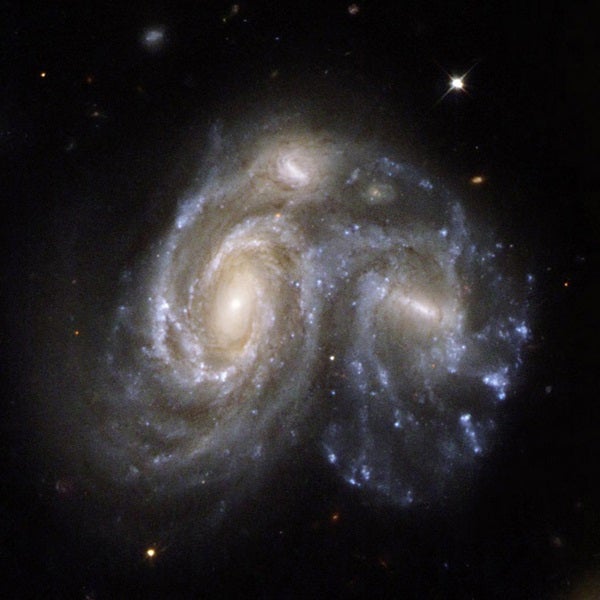Galaxy mergers are commonplace throughout the cosmos, building smaller galaxies into larger ones. And when galaxies merge, the supermassive black holes they contain are taken along for the ride. Such large-scale interactions can disrupt material orbiting in the vicinity of the black hole, causing changes in behavior and eventually “turning up” the accretion rate onto the black hole, creating an active galactic nucleus, or AGN.
Now, a recent study utilizing data from NASA’s NuSTAR X-ray telescope has tracked merging galaxies — and their black holes — to show that during the later stages of this process, the black holes become “cocooned” in thick swaths of gas and dust, hiding them from the sight even as they gobble material at higher rates.
The study, published in the Monthly Notices of the Royal Astronomical Society, examined 52 supermassive black holes in nearby merging galaxies to determine how galaxies and their black holes grow together, especially during interactions such as mergers. While astronomers know that black holes grow rapidly as gas and dust fall into the singularity, there is still some uncertainty as to how this process is triggered.
Galaxy mergers in particular have often been cited as possible triggering events that could disrupt gas and dust at large distances from the black hole, funneling it into the center of the galaxy where it can lose enough energy to eventually fall into the growing black hole, rather than settle safely into orbit around it.
However, that material can also form a shroud around the black hole, making it more difficult to detect and study. The shroud is so thick that it blocks all but the most energetic light (such as high-energy X-rays) from escaping. Thus, the study was conducted with NuSTAR because of the telescope’s sensitivity to high-energy X-rays, whereas other facilities, such as the Chandra X-ray Observatory, the Swift mission, and the X-ray Multi-Mirror Mission (XMM-Newton), are only sensitive to X-rays with lower energies. When high-energy X-rays are detected but low-energy X-rays are missing, astronomers know that the AGN is surrounded by a shell of thick material that isn’t letting most of its emission escape.
By comparing the amount of high- and low-energy X-rays observed from their sample of AGN in merging galaxies, the group was able to determine that “[t]he further along the merger is, the more enshrouded the AGN will be,” explained lead author Claudio Ricci in a press release.
“Galaxies that are far along in the merging process are completely covered in a cocoon of gas and dust.” In fact, the AGN in the study that resided within galaxies in the later stages of merging (about half the sample) were about 95 percent enshrouded in dust, based on their X-ray emission.
While all active black holes are believed to have some amount of gas and dust in an obscuring torus around them, such a high percentage of obscuration in these particular AGN can’t be explained solely by that torus, the authors stated in their study. Instead, it indicates that the galaxy merger has caused large amounts of gas and dust to move into the center of the galaxy, particularly when compared with isolated galaxies that aren’t undergoing mergers or have just begun to merge.
This study reinforces the idea that AGN tend to do most of their accreting during the later stages of a merger, and are heavily obscured during this time. Said Ricci, “The results further our understanding of the mysterious origins of the relationship between a black hole and its host galaxy.”










